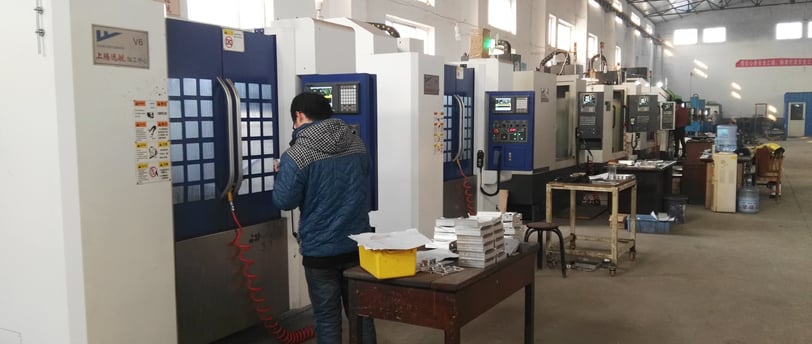Wear Resistance of Stamping Die and Surface Treatment Technology
3/1/2025


Introduction to Stamping Dies and Their Importance
Stamping dies are crucial tools used in manufacturing processes that shape metal sheets into desired forms through applying force. These dies operate through stamping, whereby punches and dies cut, bend, or shape materials, allowing for the efficient mass production of components in various industries. Their importance cannot be overstated, as they significantly contribute to product quality and consistency while optimizing production workflows.
Different types of stamping dies exist, each designed for specific applications. The three primary categories include progressive dies, compound dies, and transfer dies. Progressive dies are utilized to carry out multiple operations in one station, making them ideal for complex parts. Compound dies perform several die operations in a single stroke, while transfer dies manipulate the sheet metal between stations for detailed multi-operation tasks. The choice of die is pertinent to the efficiency of production and the complexity of the elements being manufactured.
One of the paramount considerations in the design and use of stamping dies is their wear resistance. These tools are subject to significant stresses and harsh operating conditions, leading to wear over time. Wear resistance is critical as it directly influences the longevity and performance of stamping dies. High wear rates can lead to tool failure, impacting production timelines and increasing costs due to unplanned downtime and the necessity for replacement. As worn dies perform poorly, they can compromise the dimensional accuracy and surface finish of the stamped parts, ultimately affecting the overall quality and profitability of the manufactured goods.
Manufacturers face challenges in maintaining the wear resistance of stamping dies. Frequent usage can lead to common wear types, such as abrasive, adhesive, and corrosive wear, necessitating the implementation of advanced surface treatment technologies. By addressing these wear challenges through appropriate materials and treatments, the efficiency and cost-effectiveness of stamping processes can be improved, offering significant long-term advantages in production.
Factors Affecting Wear Resistance in Stamping Dies
Wear resistance in stamping dies is a critical aspect that directly influences their performance and longevity. Several key factors contribute to this resistance, including material selection, die geometry, operational conditions, and environmental factors. Understanding these elements is essential for optimizing die life and ensuring efficient manufacturing processes.
The first factor, material selection, plays a significant role in determining the wear resistance of stamping dies. Materials with high hardness and toughness, such as tool steels and carbide composites, are often preferred due to their ability to withstand the stresses imposed during forming operations. Moreover, advanced surface treatments, such as nitriding or coating, can further enhance the base material's properties, providing an additional layer of protection against wear.
Die geometry also impacts wear resistance significantly. The design of the die, including its contours and surface finish, influences the distribution of stress during stamping operations. For instance, sharp edges may be more prone to wear, whereas rounded edges can help distribute forces more evenly, thereby minimizing localized wear. The overall shape and size of the stamping die must be carefully considered to ensure optimal performance and durability.
Operational conditions are another critical aspect influencing wear resistance. Factors such as the force applied during stamping, the speed of operation, and the temperature at which the process occurs can dramatically affect the wear rates of stamping dies. High forces may lead to increased wear, while excessive speeds or temperatures can exacerbate material degradation. It’s important to strike a balance between these factors to enhance die life and reduce maintenance costs.
Lastly, environmental conditions, including humidity and the presence of corrosive substances, can further influence the wear resistance of stamping dies. Maintaining a controlled environment is crucial, as external factors can accelerate the deterioration of die materials, subsequently impacting their overall functionality and lifespan. Understanding the interplay of these factors is vital for improving wear performance in stamping dies.
Surface Treatment Technologies for Enhancing Wear Resistance
The wear resistance of stamping dies is a critical factor in ensuring their longevity and effectiveness in various manufacturing processes. Several surface treatment technologies have been developed to enhance this property, including hardening techniques, coatings, and surface modification methods. Each of these technologies offers specific advantages and limitations that can impact their application in diverse industrial settings.
One of the most common methods for increasing wear resistance is hardening, which involves the physical alteration of the die material through processes such as quenching and tempering. Hardening increases the hardness of the die, making it less susceptible to wear during stamping operations. However, the increased brittleness resulting from some hardening techniques may lead to chipping or cracking under certain conditions.
Coatings also play a pivotal role in enhancing die wear resistance. Techniques such as electroplating and thermal spraying can apply thin layers of hard materials, such as tungsten carbide or chromium, which significantly improve the surface hardness and reduce friction during the stamping process. The primary limitation of coatings is the potential for delamination or wear of the coating itself, especially under high-stress conditions.
Surface modification techniques, including nitriding and physical vapor deposition (PVD) coatings, have gained popularity for their effectiveness. Nitriding infuses nitrogen into the surface layer of steel dies, creating a hard, wear-resistant case while preserving the toughness of the core material. PVD coatings, on the other hand, deposit thin films of hard materials using vaporization techniques, offering customized properties tailored to specific applications.
Real-world applications demonstrate the effectiveness of these surface treatment technologies. For instance, automotive and aerospace industries utilize precisely treated stamping dies to ensure high-quality components with reduced production costs. By choosing the appropriate surface treatment method, manufacturers can enhance the wear resistance and durability of stamping dies significantly.
Future Trends in Wear Resistance and Surface Treatments
The landscape of wear resistance and surface treatment technologies is evolving rapidly. As the demand for stamping dies with superior durability increases, researchers and manufacturers are focusing on emerging materials and innovative treatments that can significantly enhance wear resistance. One notable trend is the exploration of advanced composite materials that combine the strengths of various elements to achieve higher performance levels. These composites are engineered to withstand extreme conditions, making them ideal for high-volume stamping applications.
In addition to materials, the field is witnessing a surge in innovative surface treatment techniques that improve not only wear resistance but also other properties such as corrosion resistance and thermal stability. Techniques such as laser surface hardening and nanostructured coatings are gaining traction due to their effectiveness in enhancing the lifespan of stamping dies. The development of environmentally friendly surface treatments is also prominent, aligning with global sustainability goals while maintaining or improving performance metrics.
Furthermore, the integration of technology plays a pivotal role in optimizing both the design and treatment processes of stamping dies. The advent of artificial intelligence (AI) and machine learning (ML) allows for data-driven decisions in material selection, process optimization, and predictive maintenance. These technologies facilitate the simulation of different wear conditions, enabling engineers to design stamping dies that preemptively address potential wear issues. By leveraging big data analytics, manufacturers can refine their processes and predict the lifespan of dies more accurately, reducing downtime and improving overall efficiency.
As these advancements continue to unfold, the implications for the manufacturing industry are far-reaching. Enhanced wear resistance and smarter surface treatments will not only lead to more reliable and cost-effective production but will also support industries in meeting the growing demands for high-quality products. The future of stamping dies, therefore, looks promising with the convergence of innovative materials, advanced treatments, and cutting-edge technological tools.
